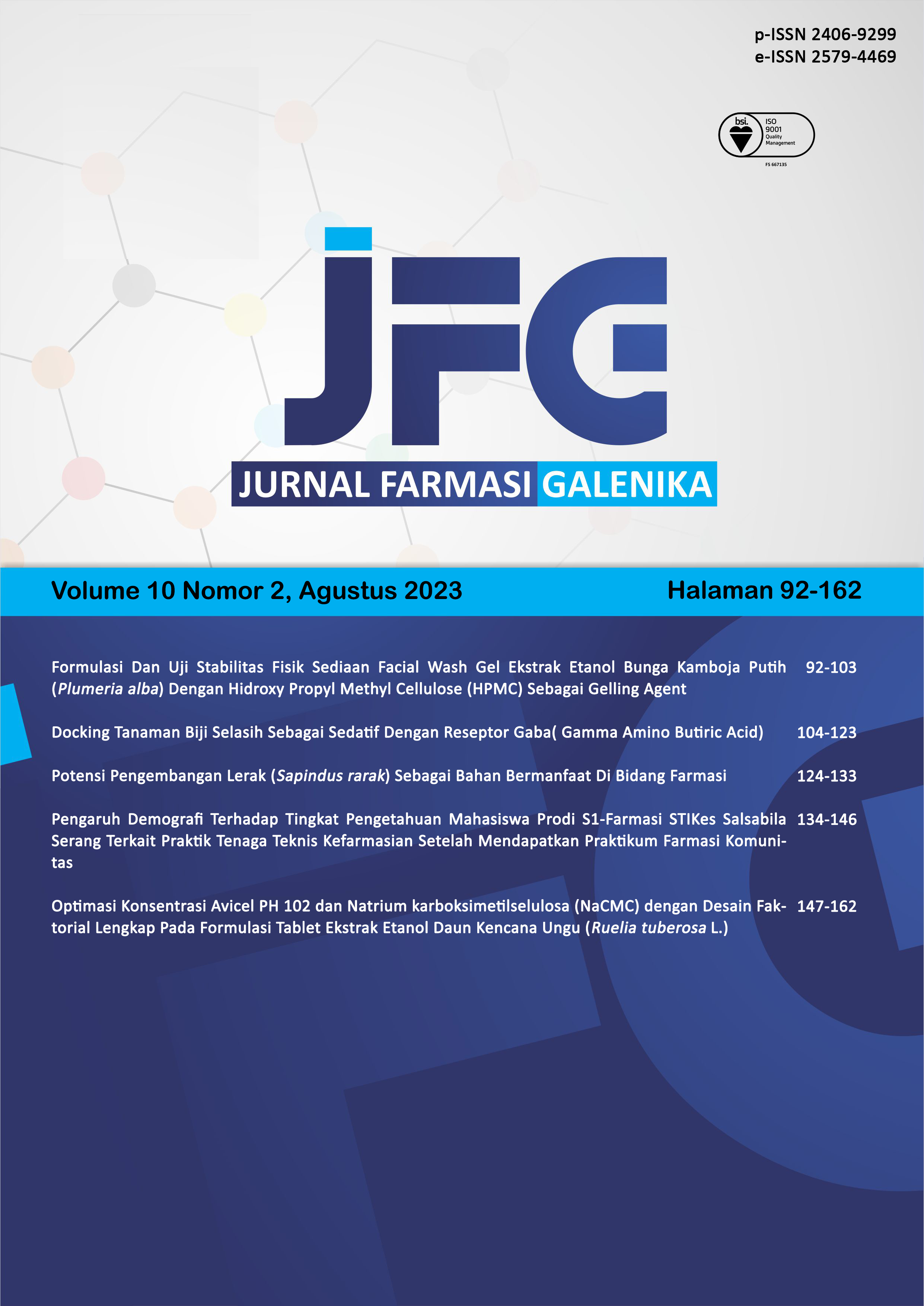The Potential Development Of Lerak (Sapindus Rarak) As A Useful Ingredient In The Pharmaceutical Field
POTENSI PENGEMBANGAN LERAK (Sapindus rarak) SEBAGAI BAHAN BERMANFAAT DI BIDANG FARMASI
DOI:
https://doi.org/10.70410/jfg.v10i2.283Keywords:
Lerak, Sapindus rarak, Saponin, plant based surfactantAbstract
Lerak (Sapindus rarak) adalah salah satu tanaman tropis yang tumbuh dengan baik di Indonesia. Secara tradisional, lerak dapat dipergunakan di berbagai bidang seperti kesehatan, pertanian, makanan, hingga fashion. Kandungan aktif pada lerak masih terus ditinjau dan dipelajari untuk dapat dimanfaatkan lebih lanjut. Artikel ini bertujuan untuk memberikan tinjauan mengenai buah lerak beserta potensi pengembangan dan pemanfaatannya di bidang farmasi. Buah, biji, daun, kulit batang lerak dapat digunakan untuk berbagai manfaat. Banyak potensi pengembangan lerak untuk dibuat menjadi suatu bentuk sediaan farmasi yang memiliki nilai jual dan kebermanfaatan yang lebih tinggi.
Downloads
References
Artha, I. W. W., Hendrayana, M. A., & Sukrama, I. D. M. UJI DAYA HAMBAT EKSTRAK ETANOL BUAH LERAK (Sapindus rarak) TERHADAP BAKTERI Staphylococcus epidermidis. Jurnal Medika Udayana, 11(5), 14-18. https://ojs.unud.ac.id/index.php/eum/article/download/68635/44737
Aryanti, N., Heny, D. R., & Nafiunisa, A. 2020. Optimization of ultrasound-assisted extraction of rarak saponin from Sapindus rarak DC. using response surface methodology (RSM). AIP Conference Proceedings, 2197. https://doi.org/10.1063/1.5140912
Fatmawati, I. 2014. Efektivitas buah lerak (Sapindus rarak de candole) sebagai bahan pembersih logam perak, perunggu, dan besi. Borobudur, 8(2), 24-31. https://doi.org/10.33374/jurnalkonservasicagarbudaya.v8i2.129
Hariana, A., Hidayat, R. S., Mursito, B., Lingga, P., & Tim Penulis PS. 2015. Kitab resep herbal. Penebar Swadaya.
Inarah, F., Hariyanto, I. H., & Haryanto, Y. 2017. Anti-fertility effect of ethanol extract of lerak (Sapindus rarak DC) fruits in female Sprague Dawley Rats. Nusantara Bioscience, 9(1), 102–106. https://doi.org/10.13057/NUSBIOSCI/N090118
Kelik, M., & Zuliatus, E. 2018. Uji Efektivitas Ekstrak Buah Lerak (Sapindus rarak DC) sebagai Repelan Anti Nyamuk Aedes aegypti. Proceeding of Biology Education, 2(1), 42-49. http://journal.unj.ac.id/unj/index.php/pbe
Pradigdo, S. F., Broto, R. T. W., & Purbawati, D. 2022. Pemanfaatan Teknologi Mesin Disk Mill Dalam Pembuatan Sabun Lerak Pada Ukm Cv Rena Guna Meningkatkan Kualitas Dan Kuantitas Sebagai Produk Unggulan Masyarakat Kota Semarang. Inisiatif: Jurnal Pengabdian Kepada Masyarakat, 1(1), 40-43. https://ejournal2.undip.ac.id/index.php/inisiatif/article/view/13025
Putri, A. N. Z. P. 2021. Tanaman Lerak sebagai Pengganti Sabun (1st ed.). Elementa Agro Lestari. https://www.google.co.id/books/edition/Tanaman_Lerak_sebagai_Pengganti_Sabun/GRN_EAAAQBAJ?hl=en&gbpv=0
Putri, D., Utomo, E., & Iftitah, E. 2017. Prototipe Hand Sanitizer Nanoemulsi Berbasis Surfaktan Alami Lerak (Sapindus rarak) Sebagai Antibakteri. Indonesian Journal of Essential Oil, 2(2), 23–38. https://ijeo.ub.ac.id/index.php/ijeo/article/view/51
Rahmadina, A., Rianti, D., & Meizarini, A. 2015. Uji sitotoksitas rebusan buah lerak (Sapindus rarak DC) terhadap sel BHK-21. Jurnal Material Kedokteran Gigi, 4(1), 4-5. http://jurnal.pdgi.or.id/index.php/jmkg/article/view/229
Ulung, G. 2014. Sehat alami dengan herbal. In I. Hardiman (Ed.), Institut Pertanian Bogor. Pusat Studi Biofarmaka (Vol. 7, Issue 2). PT Gramedia Pustaka Utama.
Widowati, Retno, Muhammad Firdaus Ramdani, & Sri Handayani. 2022. Senyawa Fitokimia dan Aktivitas Antibakteri Ekstrak Etanol Buah Lerak (Sapindus rarak) terhadap Tiga Bakteri Penyebab Infeksi Nosokomial. Jurnal Penelitian Kesehatan"SUARA FORIKES" (Journal of Health Research" Forikes Voice"), 13(3), 649-654. http://dx.doi.org/10.33846/sf13315
Yuniastuti, E. 2018. Substitusi Sabun Kimia Dengan Sabun Nabati Buah Lerak Yang Ramah Lingkungan. Jurnal Penelitian TEKNIKA, 18(2), 7-12. http://www.ejurnaluntri.ac.id/index.php/jpt/article/view/70
Downloads
Published
How to Cite
Issue
Section
Citation Check
License
Authors who publish in Jurnal Farmasi Galenika agree to the following terms:
This license enables reusers to distribute, remix, adapt, and build upon the material in any medium or format, so long as attribution is given to the creator. The license allows for commercial use. CC BY includes the following elements:
BY: credit must be given to the creator.
You are free to:
- Share — copy and redistribute the material in any medium or format for any purpose, even commercially.
- Adapt — remix, transform, and build upon the material for any purpose, even commercially.
- The licensor cannot revoke these freedoms as long as you follow the license terms.
Under the following terms:
- Attribution — You must give appropriate credit , provide a link to the license, and indicate if changes were made . You may do so in any reasonable manner, but not in any way that suggests the licensor endorses you or your use.
- No additional restrictions — You may not apply legal terms or technological measures that legally restrict others from doing anything the license permits.
Notices:
You do not have to comply with the license for elements of the material in the public domain or where your use is permitted by an applicable exception or limitation .
No warranties are given. The license may not give you all of the permissions necessary for your intended use. For example, other rights such as publicity, privacy, or moral rights may limit how you use the material.











